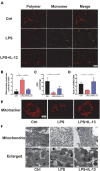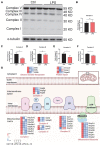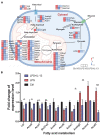IL-13 Alleviates Cardiomyocyte Apoptosis by Improving Fatty Acid Oxidation in Mitochondria
- PMID: 34604237
- PMCID: PMC8484794
- DOI: 10.3389/fcell.2021.736603
IL-13 Alleviates Cardiomyocyte Apoptosis by Improving Fatty Acid Oxidation in Mitochondria
Abstract
Sepsis-induced cardiac injury (SIC) is one of the most common complications in the intensive care unit (ICU) with high morbidity and mortality. Mitochondrial dysfunction is one of the main reasons for SIC, and Interleukin-13 (IL-13) is a master regulator of mitochondria biogenesis. The aim of the present study was to investigate the role of IL-13 in SIC and explore the underlying mechanism. It was found that reactive oxygen species (ROS) production and apoptosis were significantly increased in lipopolysaccharide (LPS)-stimulated primary cardiomyocytes, which was accompanied with obvious mitochondria dysfunction. The results of RNA-sequencing (RNA-seq), mitochondrial membrane potential, fatty acid uptake and oxidation rate suggested that treatment with IL-13 could restore the function and morphology of mitochondria, indicating that it played an important role in protecting septic cardiomyocytes. These findings demonstrated that IL-13 alleviated sepsis-induced cardiac inflammation and apoptosis by improving mitochondrial fatty acid uptake and oxidation, suggesting that IL-13 may prove to be a potential promising target for SIC treatment.
Keywords: IL-13; cardiomyocyte apoptosis; fatty acid; mitochondria; sepsis.
Copyright © 2021 Guo, Hong, Zhang, Wei, Jin, Miao, Wang, Zhou, Wang and He.
Conflict of interest statement
The authors declare that the research was conducted in the absence of any commercial or financial relationships that could be construed as a potential conflict of interest.
Figures






Similar articles
-
Lipocalin-2 participates in sepsis-induced myocardial injury by mediating lipid accumulation and mitochondrial dysfunction.Front Cardiovasc Med. 2022 Nov 7;9:1009726. doi: 10.3389/fcvm.2022.1009726. eCollection 2022. Front Cardiovasc Med. 2022. PMID: 36419491 Free PMC article.
-
PKCδ causes sepsis-induced cardiomyopathy by inducing mitochondrial dysfunction.Am J Physiol Heart Circ Physiol. 2020 Apr 1;318(4):H778-H786. doi: 10.1152/ajpheart.00749.2019. Epub 2020 Mar 6. Am J Physiol Heart Circ Physiol. 2020. PMID: 32142354 Free PMC article.
-
Overexpression of Peroxisome Proliferator-Activated Receptor γ Coactivator 1-α Protects Cardiomyocytes from Lipopolysaccharide-Induced Mitochondrial Damage and Apoptosis.Inflammation. 2020 Oct;43(5):1806-1820. doi: 10.1007/s10753-020-01255-4. Inflammation. 2020. PMID: 32529514
-
Overexpression of TGR5 alleviates myocardial ischemia/reperfusion injury via AKT/GSK-3β mediated inflammation and mitochondrial pathway.Biosci Rep. 2020 Jan 31;40(1):BSR20193482. doi: 10.1042/BSR20193482. Biosci Rep. 2020. PMID: 31909787 Free PMC article.
-
lncRNA RMRP Prevents Mitochondrial Dysfunction and Cardiomyocyte Apoptosis via the miR-1-5p/hsp70 Axis in LPS-Induced Sepsis Mice.Inflammation. 2020 Apr;43(2):605-618. doi: 10.1007/s10753-019-01141-8. Inflammation. 2020. PMID: 31900829
Cited by
-
Lipocalin-2 participates in sepsis-induced myocardial injury by mediating lipid accumulation and mitochondrial dysfunction.Front Cardiovasc Med. 2022 Nov 7;9:1009726. doi: 10.3389/fcvm.2022.1009726. eCollection 2022. Front Cardiovasc Med. 2022. PMID: 36419491 Free PMC article.
-
Mitochondrial impairment but not peripheral inflammation predicts greater Gulf War illness severity.Sci Rep. 2023 Jul 12;13(1):10739. doi: 10.1038/s41598-023-35896-w. Sci Rep. 2023. PMID: 37438460 Free PMC article.
-
Mitochondria at the Heart of Sepsis: Mechanisms, Metabolism, and Sex Differences.Int J Mol Sci. 2025 Apr 29;26(9):4211. doi: 10.3390/ijms26094211. Int J Mol Sci. 2025. PMID: 40362448 Free PMC article. Review.
-
Myocardial pyruvate dehydrogenase kinase 4 drives sex-specific cardiac responses to endotoxemia.JCI Insight. 2025 Jul 8;10(13):e191649. doi: 10.1172/jci.insight.191649. eCollection 2025 Jul 8. JCI Insight. 2025. PMID: 40626362 Free PMC article.
-
Mechanisms underlying targeted mitochondrial therapy for programmed cardiac cell death.Front Physiol. 2025 Apr 11;16:1548194. doi: 10.3389/fphys.2025.1548194. eCollection 2025. Front Physiol. 2025. PMID: 40292006 Free PMC article. Review.
References
-
- Drosatos K., Drosatos-Tampakaki Z., Khan R., Homma S., Schulze P., Zannis V., et al. (2011). Inhibition of c-Jun-N-terminal kinase increases cardiac peroxisome proliferator-activated receptor alpha expression and fatty acid oxidation and prevents lipopolysaccharide-induced heart dysfunction. J. Biol. Chem. 286 36331–36339. 10.1074/jbc.M111.272146 - DOI - PMC - PubMed
LinkOut - more resources
Full Text Sources

